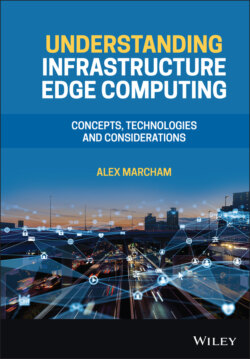Читать книгу Understanding Infrastructure Edge Computing - Alex Marcham - Страница 15
2.2 Defining the Terminology
ОглавлениеOne of the most challenging aspects of edge computing has been agreeing upon a set of terminology and using it consistently across the many industries to which edge computing is of interest. This is by no means a unique challenge when it comes to emerging technologies, but in the case of edge, it has contributed significantly to confusion between multiple groups and companies who have struggled to reconcile their individual definitions of edge computing so that ultimately a shared view of what the problem to be solved is, in addition to where it is and how to solve it, could emerge and be used.
Part of the challenge in defining edge computing is that by its very nature, the concept of an edge is contextual: An edge is at the boundary of something and often delineates the specific place where two things meet. These two things may be physical, as pieces of hardware; they may be logical, as pieces of software; or they may be more abstract, such as ownership, intent, or a business model.
Another part of the challenge has been attempting to compress the many dimensions across which a group or company may be concerned with edge computing into a small number of terms which are general enough and yet able to convey a specific meaning. Although it is appealing to create terms which describe a complex and specific set of dimensions as they relate to edge computing, this is a challenging path to create terminology which is general enough to use outside of that same group because the more dimensions a term or phrase aims to address, the less approachable it becomes.
The key to any set of terminology is consistency, and the way to achieve that even in highly technical discussions is to limit the scope of the concepts which the terminology aims to define. Once the key parameters of the definition are established, a neutral set of terminology can be created which then serves as the basis for additional layers of complexity to be added, promoting adoption and usage.
The Open Glossary of Edge Computing [1], a project arising out of the initial State of the Edge report [2] and co‐authored by the author of this book, established a neutral and limited dimension set of terminology for edge computing which has seen adoption across the industry and aims to simplify the discussions around edge computing by using the physical location of infrastructure and devices to delineate which type of edge computing each is able to perform by using the last mile network as the line between them to create a clear point of separation. Additional dimensions such as ownership, a specific business model, or any other concern can then be layered on top of this physical definition.
Along with the State of the Edge itself, the Open Glossary of Edge Computing has been adopted by the Linux Foundation’s LF Edge [3] group as an official project and continues to contribute to a shared set of terminology for edge computing to help facilitate clear discussion and shared understanding.
